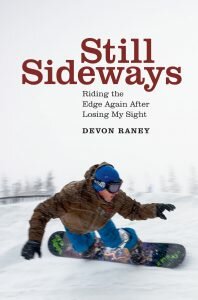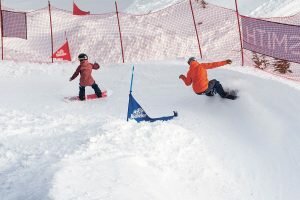
February is an exciting time for Glacier, and more people were coming into town daily in preparation for the Legendary Banked Slalom. The race is the longest-running event in snowboard history, and I was getting excited. Many of the world’s best snowboarders show up to compete in the race, and it is fun to watch them in person. One of those snowboarders is Tom Burt, who was driving up from Lake Tahoe that week for the event.
Tom Burt is an icon in the world of snowboarding. He would later become like a brother to me and a constant source of encouragement to my family. At the time, I only knew Tom as an acquaintance through our mutual friend Temple Cummins. As far back as anyone can remember, Tom had been coming to Mt. Baker and competing in the Legendary Banked Slalom. In previous years I had the good fortune of being entered in the race as well, and so I would see Tom in the wax area at Temple’s condo. I wouldn’t talk much as we all tuned up our boards, but I listened in awe while Tom told stories. He has a vast expanse of mountain knowledge and a ton of experience to share, but it was always his electric charisma and unyielding positive energy that excited me the most.
I saw Tom the morning after he arrived. Approaching me at the rope tow where Becca and I played with Madrona, Tom skipped all formalities by simply saying, “I hear you have the sickness,” and then laughed in his disarming way as he gave me a hug.
I laid out for him all that had happened over the last six months, starting at the beginning when I hit my head surfing. I rambled on for a while and completed my dismal update by admitting that within a few months I would probably be done with snowboarding forever. Adding a bit more to my pity party, I said, “I don’t think I can show up to race. I have a spot, but I don’t think I can do it.” Tom just laughed some more and said, “Go get your board, and let’s figure this out.”
Almost intuitively, I began riding 10 feet behind him and trying to mimic his every move as we worked to fine-tune the technique we soon began calling tandem snowboarding. At first, I simply tried to stay on him as close as possible so that I could catch his every movement. I also relied heavily on what my brain already knew from having 15 years of snowboarding experience. Simply put, if I stayed directly behind Tom, I knew that I wouldn’t crash into anything – unless Tom stopped abruptly, and then all I would hit would be him.
On the chairlift after each lap, we discussed how my peripheral vision worked and then how to use the remaining 15 percent of my eyesight in a way that would allow me to follow him closer, tighter in the turns, and faster down the hill. Tom is a teacher, a problem solver, and a talker. He can talk a problem through for so long that a solution eventually just appears.
“What do you see, Raney?” Tom asked, with a heavy emphasis on the word “do.” “Don’t tell me what you don’t see, Raney. Just tell me what you do see and we will use what’s left.” He wanted to know what worked; he didn’t care about what was gone or broken. He and I are similar in this way. I loved hearing him say that. It reminded me of times on the job site when I would say, “Don’t tell me what we can’t do; just tell me what we can do.”
I smiled. “Alright, Burt,” I said. “I can see colors ... sort of.” He laughed, then asked what I meant. “I mean, I don’t like using the word ‘see’ because it’s not the same as it is for you. When I say I can see colors, I mean I can see a difference in colors as they present themselves to me against different backdrops. They are never very clear, and it really depends on the contrast whether or not I can identify a clean separation between colors or objects.”
“Oh, my God, Raney. Give it to me simple. Can you see the color of my jacket?” Tom laughed. I looked over at him as we rode the chairlift and moved my eyes in circles as I tried to use my sideways vision to pick up the contrasting colors.
“It’s beige,” I stated proudly. “I can see the contrast at your cuffs where your black gloves punch through.”
“Nice,” Burt replied.
“Yeah, but that jacket doesn’t show up very strongly against the snow when we’re cruising,” I said.
“OK,” Tom said enthusiastically. “Tomorrow I’ll wear a black one.”
Tom then noted that it was in my favor that snow is white. He asked if I could see the tree line. I told him I could, and it came in handy on overcast days, when the clouds turn the snow and sky the same gray, giving me vertigo. “I can’t tell up from down,” I explained. “We get a lot of gray days here at Baker, and on those days I try to ride near the trees as much as possible so I get some depth perception and definition in the sky.”
“That happens to me too,” Tom said, and I agreed that I had experienced the sensation in whiteout conditions before my vision loss.
“When you see things out of the sides of your eyes, is it clear or is it blurry?” he asked.
“I don’t know,” I replied sheepishly. “It’s pixelated, like the way old digital cameras would show things that were out of focus. It’s not necessarily blurry—and it doesn’t make me seasick—it’s just slightly fuzzy and without definition.” Tom asked if the center portion of my field of vision was black. “No, it’s a giant gray smudge, like an eraser smudge or dark thundercloud.”
“What happens when I put my finger in front of your goggles?” Tom asked, and I knew he was probably holding a finger right in front of my face. When I told him I could only see the smudge, he asked, “What if I move it over here?”
“I pick up the movement first, and if it’s close enough I can tell it’s a finger, but probably because I’ve known what a hand is for 33 years. The eye doctor says my eyesight is classified as having the ability to count fingers at a foot.”

“Crazy,” he said. For the rest of the day Tom would regularly yell, “Raney, just don’t hit anything dark!”
The following day Tom wore a black jacket, and it was amazing how much easier it was for me to follow him by the definition black on white provided. I told him that the more he moved, the easier it was for me to see him. After I suggested that he look for tight sections, ride up the walls, and cut back across, he responded, “Sweet, I like gullies.”
In the open runs Tom would carve more turns than usual and wave his arms to give me additional motion indicators to follow. He also shouted verbal cues, but we realized our speed was too fast for my brain to catch up before I ran over whatever it was that made him shout in the first place.
At the end of that first day, I felt like I had been led around the mountain by a rope. My neck was sore from tracking Tom’s every move. Eventually my neck muscles would adjust and the new muscles I was using would grow stronger. We left our boards outside the White Salmon Lodge and went in to find Rebecca and Madrona, and we all headed for the parking lot.
“Will I see you tonight at Temple’s for the wax party?”
Tom asked.
“Oh yeah, Burt. I’ll be there putting on the good stuff. If there’s one thing I need right now it’s more speed,” I said sarcastically.
“That’s the spirit, Raney,” he said, grinning and nodding his head. “We get our first runs tomorrow. You’re showing up, right?”
I smiled. “I always show up, Burt. You know that.”
Excerpted from Still Sideways: Riding the Edge Again After Losing My Sight © 2020 by Devon Raney. Reprinted with permission by Patagonia.